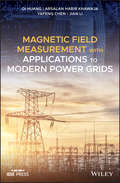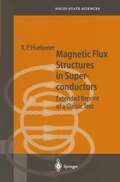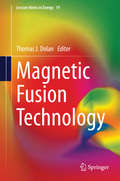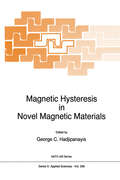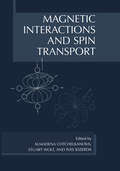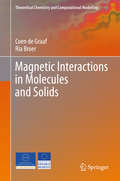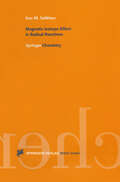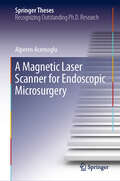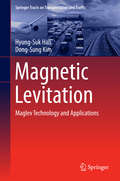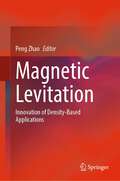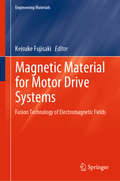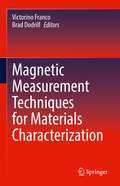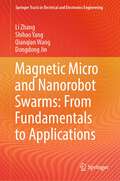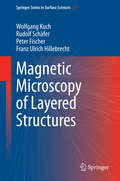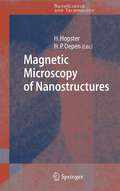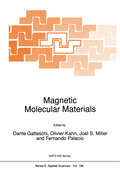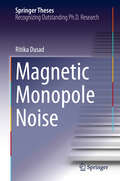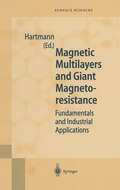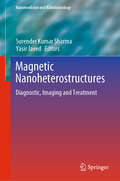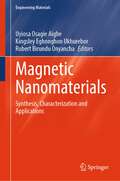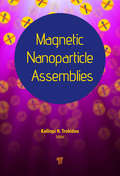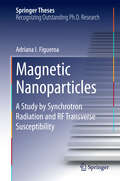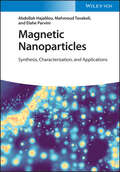- Table View
- List View
Magnetic Field Measurement with Applications to Modern Power Grids (Wiley - IEEE)
by Qi Huang Arsalan Habib Khawaja Yafeng Chen Jian LiA comprehensive review of the development, challenges and utilisation of magnetic field measurement Magnetic Field Measurement with Applications to Modern Power Grids offers an authoritative review of the development of magnetic field measurement and the application of the technology to the smart grid. The authors, noted experts in the field, present the challenges to the field of magnetics and explore the use of cutting-edge magnetic technology in the development of the smart grid. In addition, the authors discussed the applications of magnetic field measurements in substations, generations systems, transmission systems and distribution systems. The specialized applications of magnetic field measurements in these venues are explored including the typical sensors used, the field strength levels and spectral frequencies involved and the mathematics that are needed to process data measurements. The book presents the complex topic of electromagnetics in clear and understandable terms. Magnetic Field Measurement with Applications to Modern Power Grids offers researchers in the magnetic community a guide to the progress of the smart grid and helps to inspire innovation of magnetic technologies in the smart grid. The technologies of measurement are a bridge between mathematical models and application oriented practice. The book is a guide to that bridge and: Offers a comprehensive review of the development of magnetic field measurement Shows how magnetic field measurement applies to the smart grid Outlines the challenges, trends and needs for future magnetic measurement systems Includes information on the need for levels of standardisation, smart grid applications and innovative sensors Written for researchers in smart grid, power engineers, power grid companies and professionals in the measurement and test industries, Magnetic Field Measurement with Applications to Modern Power Grids is an authoritative guide that offers a clear understanding of the relationship between the magnetic field measurement and power grids.
Magnetic Field Measurement with Applications to Modern Power Grids (Wiley - IEEE)
by Qi Huang Arsalan Habib Khawaja Yafeng Chen Jian LiA comprehensive review of the development, challenges and utilisation of magnetic field measurement Magnetic Field Measurement with Applications to Modern Power Grids offers an authoritative review of the development of magnetic field measurement and the application of the technology to the smart grid. The authors, noted experts in the field, present the challenges to the field of magnetics and explore the use of cutting-edge magnetic technology in the development of the smart grid. In addition, the authors discussed the applications of magnetic field measurements in substations, generations systems, transmission systems and distribution systems. The specialized applications of magnetic field measurements in these venues are explored including the typical sensors used, the field strength levels and spectral frequencies involved and the mathematics that are needed to process data measurements. The book presents the complex topic of electromagnetics in clear and understandable terms. Magnetic Field Measurement with Applications to Modern Power Grids offers researchers in the magnetic community a guide to the progress of the smart grid and helps to inspire innovation of magnetic technologies in the smart grid. The technologies of measurement are a bridge between mathematical models and application oriented practice. The book is a guide to that bridge and: Offers a comprehensive review of the development of magnetic field measurement Shows how magnetic field measurement applies to the smart grid Outlines the challenges, trends and needs for future magnetic measurement systems Includes information on the need for levels of standardisation, smart grid applications and innovative sensors Written for researchers in smart grid, power engineers, power grid companies and professionals in the measurement and test industries, Magnetic Field Measurement with Applications to Modern Power Grids is an authoritative guide that offers a clear understanding of the relationship between the magnetic field measurement and power grids.
Magnetic Flux Structures in Superconductors: Extended Reprint of a Classic Text (Springer Series in Solid-State Sciences #6)
by R.P. HuebenerThis second edition has been brought up to date by the inclusion of an extensive new chapter on aspects relevant to high-temperature superconductors. The new edition provides researchers, engineers and other scientists with an introduction to the field and makes useful supplementary reading for graduate students in low-temperature physics.
Magnetic Fusion Technology (Lecture Notes in Energy #19)
by Thomas J. DolanMagnetic Fusion Technology describes the technologies that are required for successful development of nuclear fusion power plants using strong magnetic fields. These technologies include: • magnet systems, • plasma heating systems, • control systems, • energy conversion systems, • advanced materials development, • vacuum systems, • cryogenic systems, • plasma diagnostics, • safety systems, and • power plant design studies. Magnetic Fusion Technology will be useful to students and to specialists working in energy research.
Magnetic Hysteresis in Novel Magnetic Materials (NATO Science Series E: #338)
by G. C. HadjipanayisA detailed presentation of the physics of the various hysteresis models that are currently used to explain the magnetization reversal process, including coherent and incoherent magnetization processes, micromagnetism and its application in thin films, multilayers, nanowires, particles and bulk magnets, domain wall pinning and domain wall dynamics, and Preisach modelling. Some of the faulty concepts and interpretations that still exist in the literature are rectified. Magnetic imaging techniques are reviewed, including TEM, SEM, magnetic force microscopy, and optical microscopy. Temperature, field and angular dependence of coercivity, magnetic interactions and magnetic phenomena are reviewed and their effect on magnetic hysteresis is discussed. The magnetic properties of novel materials are discussed, including nanoparticles, nanocrystalline granular solids, particulate media, thin films, and bulk magnets. Finally, present and future applications of novel materials are presented, including magnetic and magneto-optic recording media, magneto-electronics, sensors, magnetic circuit design, and novel structures created from rigid, high-energy permanent magnets.
Magnetic Interactions and Spin Transport
by Almadena Chtchelkanova Stuart A. Wolf Yves IdzerdaStuart Wolf This book originated as a series of lectures that were given as part of a Summer School on Spintronics in the end of August, 1998 at Lake Tahoe, Nevada. It has taken some time to get these lectures in a form suitable for this book and so the process has been an iterative one to provide current information on the topics that are covered. There are some topics that have developed in the intervening years and we have tried to at least alert the readers to them in the Introduction where a rather complete set of references is provided to the current state of the art. The field of magnetism, once thought to be dead or dying, has seen a remarkable rebirth in the last decade and promises to get even more important as we enter the new millennium. This rebirth is due to some very new insight into how the spin degree of freedom of both electrons and nucleons can play a role in a new type of electronics that utilizes the spin in addition to or in place of the charge. For this new field to mature and prosper, it is important that students and postdoctoral fellows have access to the appropriate literature that can give them a sound basis in the funda mentals of this new field and I hope that this book is a very good start in this direction.
Magnetic Interactions in Molecules and Solids (Theoretical Chemistry and Computational Modelling)
by Coen de Graaf Ria BroerThis textbook is the second volume in the Theoretical Chemistry and Computational Modeling series and aims to explain the theoretical basis of magnetic interactions at a level that will be useful for master students in physical, inorganic and organic chemistry.The book gives a treatment of magnetic interactions in terms of the phenomenological spin Hamiltonians that have been such powerful tools for chemistry and physics in the past half century, starting from the simple Heisenberg and Ising Hamiltonians and ending with Hamiltonians that include biquadratic, cyclic or anisotropic exchange. On the other hand, it also explains how quantum chemical methods, reaching from simple mean field methods to accurate models that include the effects of electron correlation and spin-orbit coupling, can help to understand the magnetic properties. Connecting the two perspectives is an essential aspect of the book, since it leads to a deeper understanding of the relation between physical phenomena and basic properties. It also makes clear that in many cases one can derive magnetic coupling parameters not only from experiment, but also from accurate ab initio calculations.The book starts with introducing a selection of basic concepts and tools. Throughout the book the text is interlarded with exercises, stimulating the students to not only read but also verify the assertions and perform (parts of) the derivations by themselves. In addition, each chapter ends with a number of problems that can be used to check whether the material has been understood.
Magnetic Isotope Effect in Radical Reactions: An Introduction
by Kev M. SalikhovIn the last two decades it was demonstrated that, in addition to masses and charges, magnetic moments of nuclei are able to influence remarkably chemical reactions. This book presents the physical background (both theoretical and experimental) of the magnetic isotope effects in radical reactions in solutions. Special attention has been paid to the quantitative interpretation of the available experimental data. This book will be useful for physicists, chemists and biologists employing the isotope effect in their investigations as well as for those involved in isotope separation and isotope enrichment projects. Additionally, the magnetic isotope effect appears to be important in geochemistry and cosmochemistry. The book can be recommended for postgraduates and senior undergraduate students.
A Magnetic Laser Scanner for Endoscopic Microsurgery (Springer Theses)
by Alperen AcemogluThis book focuses on the design, development, and characterization of a compact magnetic laser scanner for microsurgical applications. In addition, it proposes a laser incision depth controller to be used in soft tissue microsurgeries.The use of laser scanners in soft tissue microsurgery results in high quality ablations with minimal thermal damage to surrounding tissue. However, current scanner technologies for microsurgery are limited to free-beam lasers, which require direct line-of-sight to the surgical site, from outside the patient. Developing compact laser micromanipulation systems is crucial to introducing laser-scanning capabilities in hard-to-reach surgical sites, e.g., vocal cords.In this book, the design and fabrication of a magnetically actuated endoscopic laser scanner have been shown, one that introduces high-speed laser scanning for high quality, non-contact tissue ablations in narrow workspaces. Static and dynamic characterization of the system, its teleoperation through a tablet device, and its control modelling for automated trajectory executions have been shown using a fabricated and assembled prototype. Following this, the book discusses how the laser position and velocity control capabilities of the scanner can be used to design a laser incision depth controller to assist surgeons during operations.
Magnetic Levitation: Maglev Technology and Applications (Springer Tracts on Transportation and Traffic #13)
by Hyung-Suk Han Dong-Sung KimThis book provides a comprehensive overview of magnetic levitation (Maglev) technologies, from fundamental principles through to the state-of-the-art, and describes applications both realised and under development. It includes a history of Maglev science and technology showing the various milestones in its advancement. The core concepts, operating principles and main challenges of Maglev applications attempted across various fields are introduced and discussed. The principle difficulties encountered when applying Maglev technology to different systems, namely air gap control and stabilization, are addressed in detail. The book describes how major advancements in linear motor and magnet technologies have enabled the development of the linear-motor-powered Maglev train, which has a high speed advantage over conventional wheeled trains and has the potential to reach speed levels achieved by aircraft. However, many expect that Maglev technology to be a green technology that is applied not only in rail transportation, but also in diverse other fields; to ensure clean transfer in LCD manufacturing, in ropeless high speed elevators, small capacity rail transportation, space vehicle launchers, missile testers, energy storage, and so on. These potential applications and their unique challenges and proposed technological solutions are introduced and discussed in depth. The book will provide readers from academia, research institutes and industry with insights on where and how to apply Maglev technology, and will serve as a guide to the realization of their Maglev applications.
Magnetic Levitation: Innovation of Density-Based Applications
by Peng ZhaoThis book introduces the MagLev testing method for density measurement and density-based applications of diamagnetic and low-magnetic objects using permanent magnets. The book surveys the most relevant papers on the theory and model of various MagLev methods that have become the foundation to elucidate the principles of MagLev and the conditions for stable levitation. A thorough summary of the improvements demonstrates the applications and potential of the MagLev method in many fields. This book is separated into 11 chapters to present MagLev testing method fully, including a review of the background of MagLev, theories and basic principles of the stable levitation of object, different dimensions of applications of MagLev in the fields of mechanical engineering, chemistry, and bioengineering, and sophisticated applications of manipulation and separation. This book would benefit the audience in the field of mechanical engineering, chemistry, materials science, and bioengineering, since magnetic levitation method has proved itself suitable for the density-based analysis and applications of materials of different scales. The analysis in this book will help the audience deeply understand the mechanism of magnetic levitation, and it can serve as an instruction for the magnetic levitation procedure, or guidebook for the magnetic levitation setup. With the viewpoints and thoughts about MagLev running through this book, this book may spark the audience’s interest towards magnetic levitation method, and enlighten them to further develop Maglev method.
Magnetic Material for Motor Drive Systems: Fusion Technology of Electromagnetic Fields (Engineering Materials)
by Keisuke FujisakiThis book focuses on how to use magnetic material usefully for electrical motor drive system, especially electrical vehicles and power electronics. The contents have been selected in such a way that engineers in other fields might find some of the ideas difficult to grasp, but they can easily acquire a general or basic understanding of related concepts if they acquire even a rudimentary understanding of the selected contents.The cutting-edge technologies of magnetism are also explained. From the fundamental theory of magnetism to material, equipment, and applications, readers can understand the underlying concepts. Therefore, a new electric vehicle from the point of view of magnetic materials or a new magnetic material from the point of a view of electric vehicles can be envisioned: that is, magnetic material for motor drive systems based on fusion technology of an electromagnetic field. Magnetic material alone does not make up an electric vehicle, of course. Other components such as mechanical structure material, semiconductors, fuel cells, and electrically conductive material are important, and they are difficult to achieve. However, magnetic material involves one of the most important key technologies, and there are high expectations for its use in the future. It will be the future standard for motor-drive system researchers and of magneticmaterial researchers as well. This book is a first step in that direction.
Magnetic Measurement Techniques for Materials Characterization
by Victorino Franco Brad DodrillThis book discusses the most commonly used techniques for characterizing magnetic material properties and their applications. It provides a comprehensive and easily digestible collection and review of magnetic measurement techniques. It also examines the underlying operating principles and techniques of magnetic measurements, and presents current examples where such measurements and properties are relevant. Given the pervasive nature of magnetic materials in everyday life, this book is a vital resource for both professionals and students wishing to deepen their understanding of the subject.
Magnetic Micro and Nanorobot Swarms: From Fundamentals to Applications (Springer Tracts in Electrical and Electronics Engineering)
by Li Zhang Shihao Yang Qianqian Wang Dongdong JinThis book is focused on the attractive emerging field of micro-/nanorobot swarms (microswarms). It introduces fundamental understandings of various microswarms, including pattern generation, transformation, locomotion, and imaging. This book also demonstrates applications of micro-/nanorobot swarms in different fields, such as biomedical, environmental, and electrical applications. The detailed theoretical analysis and experimental demonstrations in this book provide readers ranging from students to researchers with a realistic picture of progress achieved in the field of micro-/nanorobot swarms.
Magnetic Microscopy of Layered Structures (Springer Series in Surface Sciences #57)
by Wolfgang Kuch Rudolf Schäfer Peter Fischer Franz Ulrich HillebrechtThis book presents the important analytical technique of magnetic microscopy. This method is applied to analyze layered structures with high resolution. This book presents a number of layer-resolving magnetic imaging techniques that have evolved recently. Many exciting new developments in magnetism rely on the ability to independently control the magnetization in two or more magnetic layers in micro- or nanostructures. This in turn requires techniques with the appropriate spatial resolution and magnetic sensitivity. The book begins with an introductory overview, explains then the principles of the various techniques and gives guidance to their use. Selected examples demonstrate the specific strengths of each method. Thus the book is a valuable resource for all scientists and practitioners investigating and applying magnetic layered structures.
Magnetic Microscopy of Nanostructures (NanoScience and Technology)
by Herbert Hopster Hans Peter OepenA comprehensive collection of overview articles on novel microscopy methods for imaging magnetic structures on the nanoscale. Written by leading scientists in the field, the book covers synchrotron based methods, spin-polarized electron methods, and scanning probe techniques. It constitutes a valuable source of reference for graduate students and newcomers to the field.
Magnetic Molecular Materials (NATO Science Series E: #198)
by D. Gatteschi O. Kahn Joel S. Miller Fernando PalacioOne of the major challenges of science in the last few years of the second millennium is learning how to design materials which can fulfill specific tasks. Ambitious as it may be, the possibilities of success are not ne~li~ble provided that all the different expertises merge to overcome the limits of eXIsting disciplines and forming new paradigms science. The NATO Advanced Research Workshop on "Magnetic Molecular Materials" was organized with the above considerations in mind in order to determine which are the most appropriate synthetic strategies, experimental techniques of investigation, and theoretical models which are needed in order to develop new classes of magnetic materials which are based on molecules rather than on metallic or ionic lattices. Why molecules? The answer may be obvious: molecular chemistry in principle fine can tune the structures and the properties of complex aggregates, and nature already provides a large number of molecular aggregates which can perform the most disparate functions. The contributions collected in this book provide a rather complete view of the current research accomplishments of magnetic molecular materials. There are several different synthetic approaches which are followed ranging from purely organic to inorganic materials. Some encouraging successes have already been achieved, even if the critical temperatures below which magnetic order is observed still are in the range requiring liquid helium.
Magnetic Monopole Noise (Springer Theses)
by Ritika DusadThis thesis presents the first ever measurement of the noise emitted by magnetic monopoles and the development of an exquisitely sensitive magnetic-field-noise spectrometer based on a superconducting quantum interference device (SQUID) that enabled it. Magnetic monopoles are highly elusive elementary particles exhibiting quantized magnetic charge. The prospects for studying them brightened recently with the theoretical discovery that the thermally excited states in certain classes of magnetic insulators exhibit all the characteristics of magnetic monopoles. Furthermore, in 2018, it was predicted that the random motion of magnetic monopoles inside would generate a very specific kind of magnetization noise. In this thesis, the author describes a new experimental technique, so-called spin noise spectroscopy, and the subsequent discovery of virtually all of the predicted features of the magnetic noise expected from a dense fluid of magnetic monopoles in crystals of Dy2Ti2O7. Remarkably, because this magnetic monopole noise occurs in the frequency range below 20kHz, when amplified by the SQUID it is actually audible to humans.
Magnetic Multilayers and Giant Magnetoresistance: Fundamentals and Industrial Applications (Springer Series in Surface Sciences #37)
by H.A.M. van Berg R. Coehoorn M.A.M. Gijs P. Grünberg T. Rasing K. RöllThis unified overview of recent progress in a growing, multi-disciplinary field places special emphasis on the industrial applications of magnetic multilayered materials. The text describes a wide range of physical aspects, together with experimental and theoretical methods.
Magnetic Nanoheterostructures: Diagnostic, Imaging and Treatment (Nanomedicine and Nanotoxicology)
by Surender Kumar Sharma Yasir JavedThis book contains most updated information on synthesis of magnetic nanohybrids, their physio-chemical properties, and key biological applications. It highlights the complexity of nanoheterostructures, especially magnetic metal oxides, ferrites and doped magnetic nanomaterials, and discusses their potential applications in the early detection, imaging and treatment of cancer. It also covers the toxicity and risk assessment of multifunctional nanomaterials. Providing an overview of magnetic nanoheterostructures, it appeals to a wide audience, from beginners and graduate-level students to experts in academia and industry.
Magnetic Nanomaterials: Synthesis, Characterization and Applications (Engineering Materials)
by Uyiosa Osagie Aigbe Kingsley Eghonghon Ukhurebor Robert Birundu OnyanchaThis book explores some of the latest and recent advances in the synthesis, characterization and applications of magnetic nanomaterials. It starts with an overview of magnetic nanomaterials, followed by a list of their synthesis and characterization methods. The book shows the potential of magnetic materials in different applications, including theranostic nanomedicine, heavy metals detection, dyes sensing, solar cells, wastewater treatment, decontamination of soil, and detection and monitoring of toxic gases. Moreover, it explores their use as drug and gene delivery agents, their biosafety and bioregulation facets, tissue engineering applications, and their potential for combating pathogens
Magnetic Nanoparticle Assemblies
by Kalliopi N. TrohidouMagnetic nanoparticles with diameters in the range of a few nanometers are today at the cutting edge of modern technology and innovation because of their use in numerous applications ranging from engineering to biomedicine. A great deal of scientific interest has been focused on the functionalization of magnetic nanoparticle assemblies. The underst
Magnetic Nanoparticles: A Study by Synchrotron Radiation and RF Transverse Susceptibility (Springer Theses)
by Adriana I. FigueroaMagnetic nanoparticles (NPs) are finding their place in many modern technologies such as electronics (memory or spintronic devices) and medicine (contrast media, electromagnetic thermal therapy) to name just a few examples. The application of modern techniques based on synchrotron radiation, in particular X-ray spectroscopies, as well as an rf transverse susceptibility probe, built ad hoc, allowed the author to investigate several classes of magnetic NPs with diverse applications. For example, the interesting anisotropic properties of CoW and CoPt NPs revealed new magnetic behaviour and phases. Gold NPs prepared on a biological template from Sulfolobus acidocaldarius S-layer, were shown to possess intrinsic magnetism caused by the electron exchange with the sulfur atoms of the template. Silica and oleic acid coated magnetite NPs showed excellent human compatibility while preserving the bulk magnetic figures of merit. Both macroscopic and microscopic properties of all these NPs, hitherto unexplained, have been revealed for the first time.
Magnetic Nanoparticles: Synthesis, Characterization, and Applications
by Abdollah Hajalilou Mahmoud Tavakoli Elahe ParviniMagnetic Nanoparticles Learn how to make and use magnetic nanoparticles in energy research, electrical engineering, and medicine In Magnetic Nanoparticles: Synthesis, Characterization, and Applications, a team of distinguished engineers and chemists delivers an insightful overview of magnetic materials with a focus on nano-sized particles. The book reviews the foundational concepts of magnetism before moving on to the synthesis of various magnetic nanoparticles and the functionalization of nanoparticles that enables their use in specific applications. The authors also highlight characterization techniques and the characteristics of nanostructured magnetic materials, like superconducting quantum interference device (SQUID) magnetometry. Advanced applications of magnetic nanoparticles in energy research, engineering, and medicine are also discussed, and explicit derivations and explanations in non-technical language help readers from diverse backgrounds understand the concepts contained within. Readers will also find: A thorough introduction to magnetic materials, including the theory and fundamentals of magnetization In-depth explorations of the types and characteristics of soft and hard magnetic materials Comprehensive discussions of the synthesis of nanostructured magnetic materials, including the importance of various preparation methods Expansive treatments of the surface modification of magnetic nanoparticles, including the technical resources employed in the process Perfect for materials scientists, applied physicists, and measurement and control engineers, Magnetic Nanoparticles: Synthesis, Characterization, and Applications will also earn a place in the libraries of inorganic chemists.
Magnetic Nanoparticles: Synthesis, Characterization, and Applications
by Abdollah Hajalilou Mahmoud Tavakoli Elahe ParviniMagnetic Nanoparticles Learn how to make and use magnetic nanoparticles in energy research, electrical engineering, and medicine In Magnetic Nanoparticles: Synthesis, Characterization, and Applications, a team of distinguished engineers and chemists delivers an insightful overview of magnetic materials with a focus on nano-sized particles. The book reviews the foundational concepts of magnetism before moving on to the synthesis of various magnetic nanoparticles and the functionalization of nanoparticles that enables their use in specific applications. The authors also highlight characterization techniques and the characteristics of nanostructured magnetic materials, like superconducting quantum interference device (SQUID) magnetometry. Advanced applications of magnetic nanoparticles in energy research, engineering, and medicine are also discussed, and explicit derivations and explanations in non-technical language help readers from diverse backgrounds understand the concepts contained within. Readers will also find: A thorough introduction to magnetic materials, including the theory and fundamentals of magnetization In-depth explorations of the types and characteristics of soft and hard magnetic materials Comprehensive discussions of the synthesis of nanostructured magnetic materials, including the importance of various preparation methods Expansive treatments of the surface modification of magnetic nanoparticles, including the technical resources employed in the process Perfect for materials scientists, applied physicists, and measurement and control engineers, Magnetic Nanoparticles: Synthesis, Characterization, and Applications will also earn a place in the libraries of inorganic chemists.
